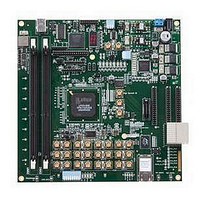LFE3-95E-PCIE-DKN Lattice, LFE3-95E-PCIE-DKN Datasheet - Page 36

LFE3-95E-PCIE-DKN
Manufacturer Part Number
LFE3-95E-PCIE-DKN
Description
MCU, MPU & DSP Development Tools LatticeECP3 PCI Express Dev Kit
Manufacturer
Lattice
Datasheet
1.LFE3-150EA-7FN672CTW.pdf
(130 pages)
Specifications of LFE3-95E-PCIE-DKN
Processor To Be Evaluated
LFE3-95EA-x
Processor Series
LatticeECP3
Interface Type
SPI
Operating Supply Voltage
1.2 V to 3.3 V
Lead Free Status / RoHS Status
Lead free / RoHS Compliant
- Current page: 36 of 130
- Download datasheet (3Mb)
Architecture
Lattice Semiconductor
LatticeECP3 Family Data Sheet
Input signals are fed from the sysI/O buffer to the input register block (as signal DI). If desired, the input signal can
bypass the register and delay elements and be used directly as a combinatorial signal (INDD), a clock (INCK) and,
in selected blocks, the input to the DQS delay block. If an input delay is desired, designers can select either a fixed
delay or a dynamic delay DEL[3:0]. The delay, if selected, reduces input register hold time requirements when
using a global clock.
The input block allows three modes of operation. In single data rate (SDR) the data is registered with the system
clock by one of the registers in the single data rate sync register block.
In DDR mode, two registers are used to sample the data on the positive and negative edges of the modified DQS
(ECLKDQSR) in the DDR Memory mode or ECLK signal when using DDR Generic mode, creating two data
streams. Before entering the core, these two data streams are synchronized to the system clock to generate two
data streams.
A gearbox function can be implemented in each of the input registers on the left and right sides. The gearbox func-
tion takes a double data rate signal applied to PIOA and converts it as four data streams, INA, IPA, INB and IPB.
The two data streams from the first set of DDR registers are synchronized to the edge clock and then to the system
clock before entering the core. Figure 2-30 provides further information on the use of the gearbox function.
The signal DDRCLKPOL controls the polarity of the clock used in the synchronization registers. It ensures ade-
quate timing when data is transferred to the system clock domain from the ECLKDQSR (DDR Memory Interface
mode) or ECLK (DDR Generic mode). The DDRLAT signal is used to ensure the data transfer from the synchroni-
zation registers to the clock transfer and gearbox registers.
The ECLKDQSR, DDRCLKPOL and DDRLAT signals are generated in the DQS Read Control Logic Block. See
Figure 2-37 for an overview of the DQS read control logic.
Further discussion about using the DQS strobe in this module is discussed in the DDR Memory section of this data
sheet.
Please see TN1180,
LatticeECP3 High-Speed I/O Interface
for more information on this topic.
2-33
Related parts for LFE3-95E-PCIE-DKN
Image
Part Number
Description
Manufacturer
Datasheet
Request
R

Part Number:
Description:
FPGA - Field Programmable Gate Array 92K LUTs, 490 I/O 8 Speed
Manufacturer:
Lattice

Part Number:
Description:
FPGA - Field Programmable Gate Array 92K LUTs, 380 I/O 7 Speed
Manufacturer:
Lattice

Part Number:
Description:
FPGA - Field Programmable Gate Array 92K LUTs, 295 I/O 7 Speed
Manufacturer:
Lattice

Part Number:
Description:
FPGA - Field Programmable Gate Array 92K LUTs, 380 I/O 6 Speed
Manufacturer:
Lattice

Part Number:
Description:
FPGA - Field Programmable Gate Array 92K LUTs, 490 I/O 6 Speed
Manufacturer:
Lattice

Part Number:
Description:
FPGA - Field Programmable Gate Array 92K LUTs, 295 I/O 8 Speed
Manufacturer:
Lattice

Part Number:
Description:
FPGA - Field Programmable Gate Array 92K LUTs, 490 I/O 8 Speed
Manufacturer:
Lattice

Part Number:
Description:
FPGA - Field Programmable Gate Array 92K LUTs, 380 I/O 8 Speed
Manufacturer:
Lattice

Part Number:
Description:
FPGA - Field Programmable Gate Array 92K LUTs, 490 I/O 6 Speed
Manufacturer:
Lattice

Part Number:
Description:
FPGA - Field Programmable Gate Array 92K LUTs, 295 I/O 6 Speed
Manufacturer:
Lattice

Part Number:
Description:
FPGA - Field Programmable Gate Array 92K LUTs, 490 I/O 7 Speed
Manufacturer:
Lattice

Part Number:
Description:
FPGA - Field Programmable Gate Array 92K LUTs, 295 I/O 8 Speed
Manufacturer:
Lattice

Part Number:
Description:
FPGA - Field Programmable Gate Array 92K LUTs, 490 I/O 7 Speed
Manufacturer:
Lattice

Part Number:
Description:
FPGA - Field Programmable Gate Array 92K LUTs, 380 I/O 6 Speed
Manufacturer:
Lattice

Part Number:
Description:
FPGA - Field Programmable Gate Array 92K LUTs, 295 I/O 7 Speed
Manufacturer:
Lattice










